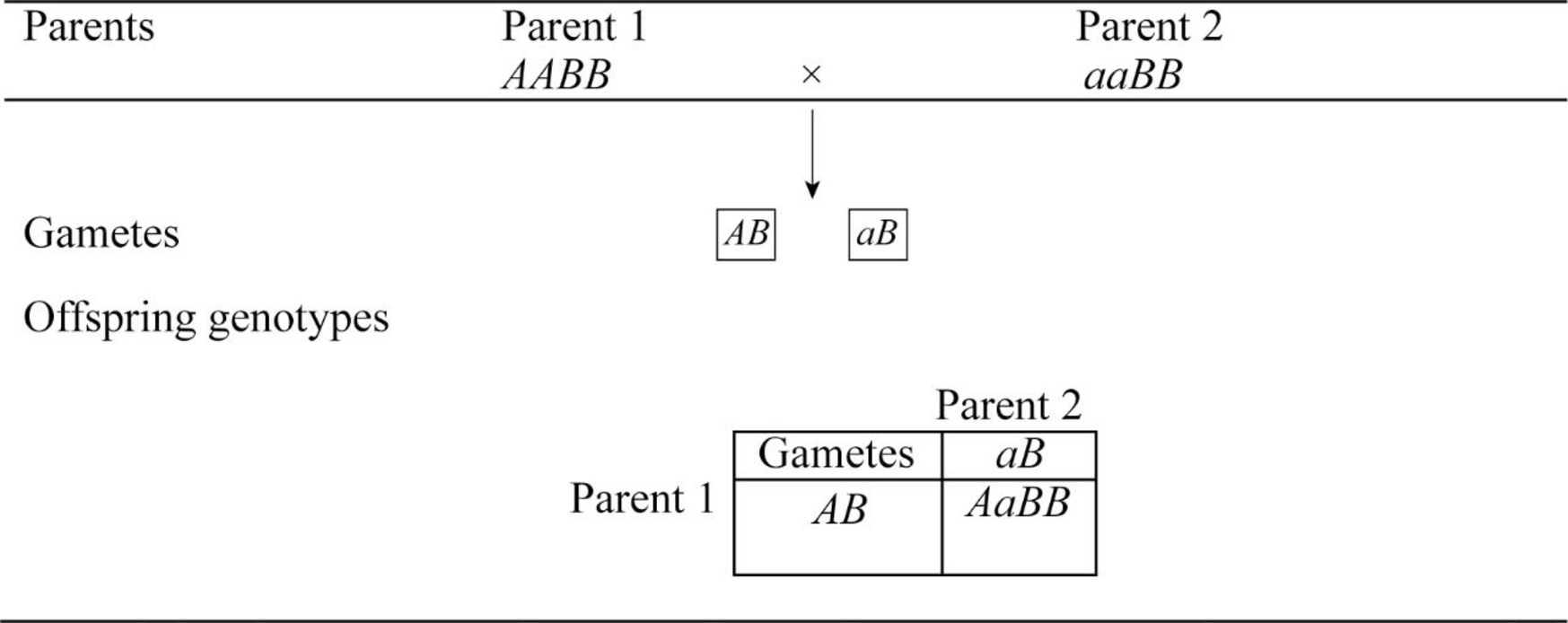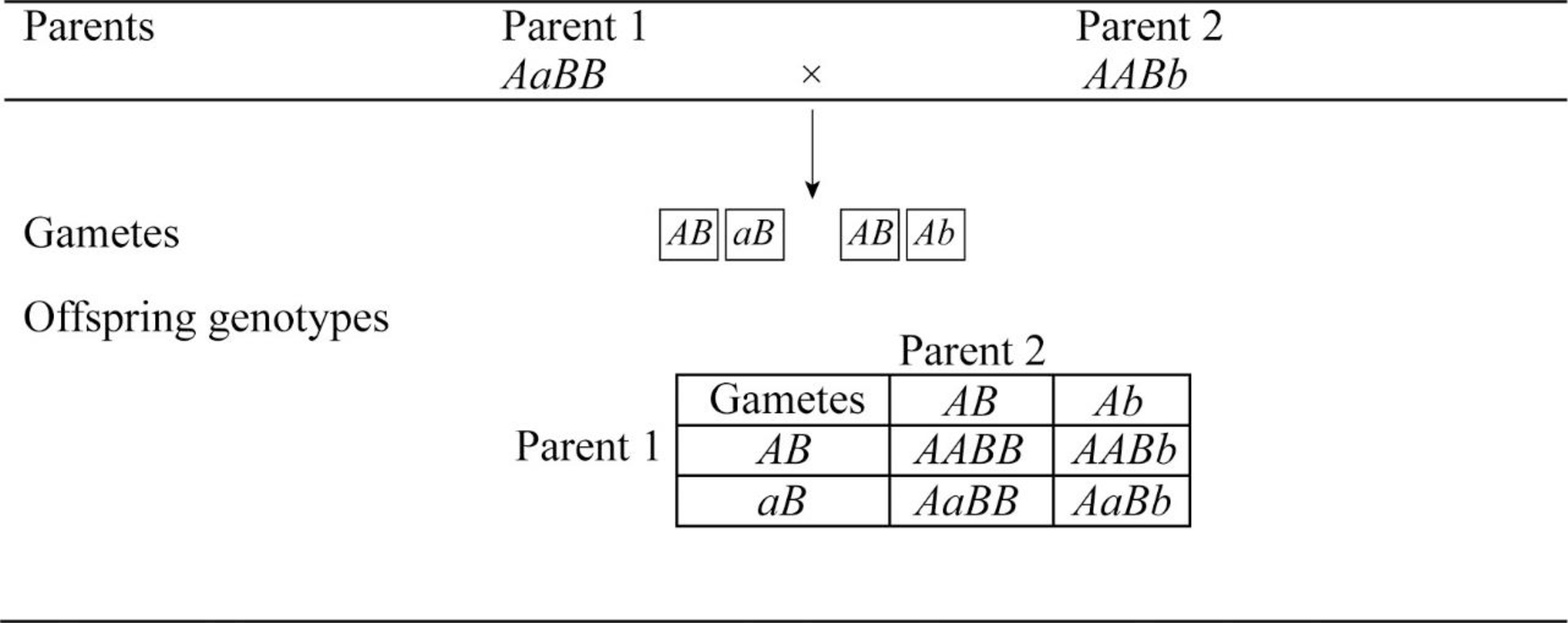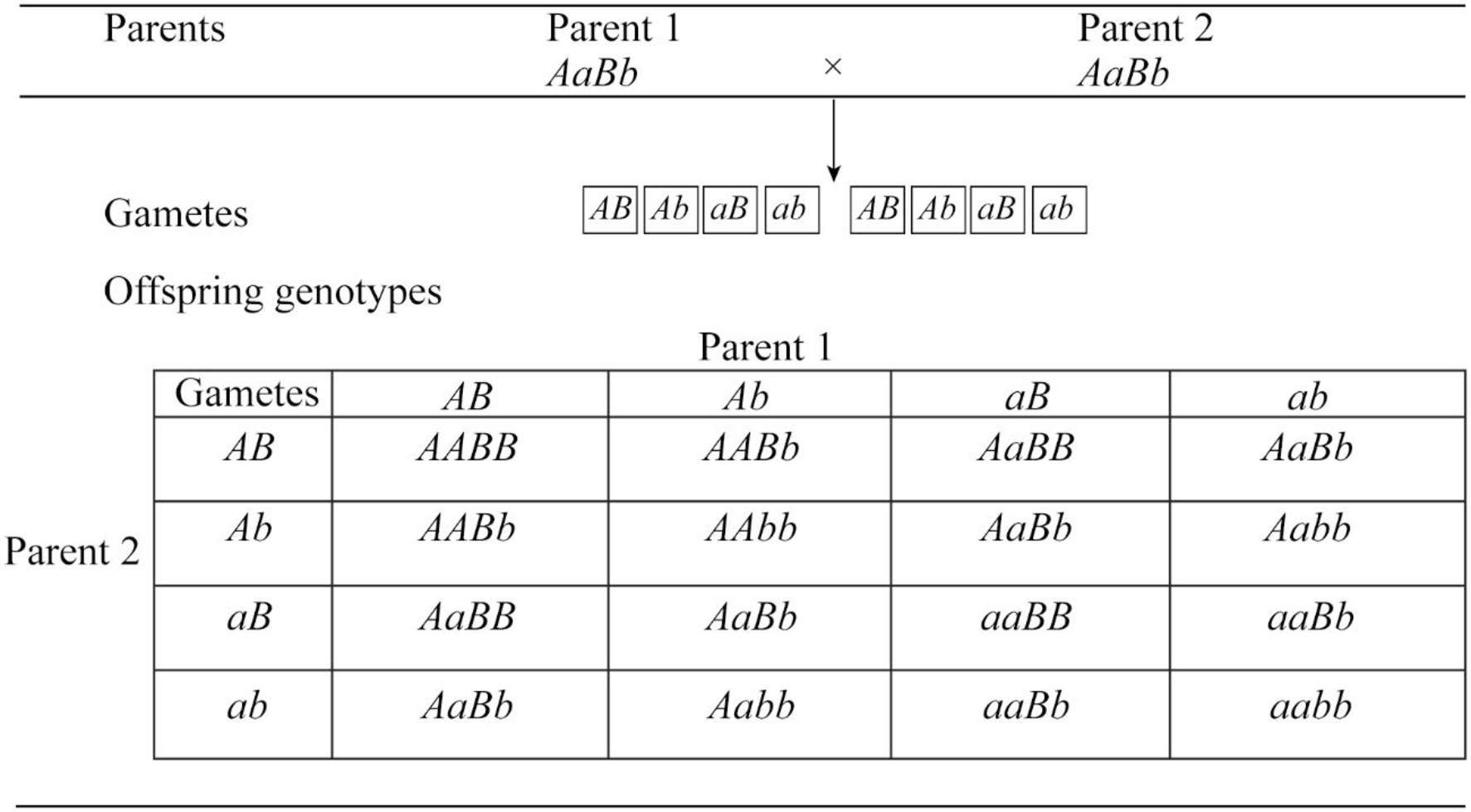
Concept explainers
Still referring to Problem 1, what will be the possible genotypes of offspring from the following matings? With what frequency will each genotype show up?
- a. AABB × aaBB
- b. AaBB × AABb
- c. AaBb × aabb
- d. AaBb × AaBb
a.
To predict: The predicted genotype frequencies among the offspring for the mating AABB × aaBB.
Introduction: The law of independent assortment and law of segregation are the laws proposed by Gregor Johann Mendel, a geneticist. Mendel proposed the law of independent assortment based on the results of monohybrid cross that “two alleles at any locus tend to separate from each other during meiosis, so they end up in different gametes”. Mendel proposed the law of independent assortment based on the results of dihybrid cross that “alleles at one locus tend to assort into gametes independently of alleles at other loci”. The number of possible allele combination for the given genotype is given by the formula 2n where “n” is the number of heterozygous alleles that are present.
Explanation of Solution
A monohybrid cross is constructed with Punnett square for the parents having the genotype AABB and aaBB.

All the offspring have the same genotype AaBB. Therefore, there is no genotype frequency.
b.
To predict: The predicted genotype frequencies among the offspring for the mating AaBB × AABb.
Introduction: The law of independent assortment and law of segregation are the laws proposed by Gregor Johann Mendel, a geneticist. Mendel proposed the law of independent assortment based on the results of monohybrid cross that “two alleles at any locus tend to separate from each other during meiosis, so they end up in different gametes”. Mendel proposed the law of independent assortment based on the results of dihybrid cross that “alleles at one locus tend to assort into gametes independently of alleles at other loci”. The number of possible allele combination for the given genotype is given by the formula 2n where “n” is the number of heterozygous alleles that are present.
Explanation of Solution
A monohybrid cross is constructed with Punnett square for the parents having the genotype AaBB and AABb.

The following is the frequency of genotypes.
Total number of possible genotypes = 4.
AABB=
AABb=
AaBB=
AaBb =
The frequency of all four genotypes is 25%.
c.
To predict: The predicted genotype frequencies among the offspring for the mating AaBb × aabb.
Introduction: The law of independent assortment and law of segregation are the laws proposed by Gregor Johann Mendel, a geneticist. Mendel proposed the law of independent assortment based on the results of monohybrid cross that “two alleles at any locus tend to separate from each other during meiosis, so they end up in different gametes”. Mendel proposed the law of independent assortment based on the results of dihybrid cross that “alleles at one locus tend to assort into gametes independently of alleles at other loci”. The number of possible allele combination for the given genotype is given by the formula 2n where “n” is the number of heterozygous alleles that are present.
Explanation of Solution
A monohybrid cross is constructed with Punnett square for the parents having the genotype AaBb and aabb

The following is the frequency of genotypes.
Total number of possible genotypes = 4.
AABB=
aaBB=
Aabb=
aabb =
The frequency of all four genotypes is 25%.
d.
To predict: The predicted genotype frequencies among the offspring for the mating AaBb × AaBb.
Introduction: The law of independent assortment and law of segregation are the laws proposed by Gregor Johann Mendel, a geneticist. Mendel proposed the law of independent assortment based on the results of monohybrid cross that “two alleles at any locus tend to separate from each other during meiosis, so they end up in different gametes”. Mendel proposed the law of independent assortment based on the results of dihybrid cross that “alleles at one locus tend to assort into gametes independently of alleles at other loci”. The number of possible allele combination for the given genotype is given by the formula 2n where “n” is the number of heterozygous alleles that are present.
Explanation of Solution
A monohybrid cross is constructed with Punnett square for the parents having the genotype AaBb and AaBb.

The following is the frequency of genotypes.
Total number of possible genotypes = 16.
AABB=
AABb=
AaBB=
AaBb=
AAbb=
Aabb=
aaBB=
aaBb=
aabb=
The frequency of genotypes AABB, aaBB , AAbb and aabb is 6.25%.
The frequency of genotypes AaBB, AABb, aaBb and Aabb is 12.5%.
The frequency of genotypes AaBb is 25%.
Want to see more full solutions like this?
Chapter 19 Solutions
EBK HUMAN BIOLOGY
- 9 S es Read the section "Investigating Life: In (Extremely) Cold Blood." Then, drag and drop the terms on the left to complete the concept map. Red blood cells Genes Icefishes -have mutated have colorless Oxygen have few lack encode Blood Cellular respiration consists of- contain carries is a Platelets White blood cells carries low amounts of Hemoglobin is necessary for Plasma Protein Reset.arrow_forwardPlating 50 microliters of a sample diluted by a factor of 10-6 produced 91 colonies. What was the originalcell density (CFU/ml) in the sample?arrow_forwardEvery tutor here has got this wrong, don't copy off them.arrow_forward
- Suppose that the population from question #1 (data is in table below) is experiencing inbreeding depression (F=.25) (and no longer experiencing natural selection). Calculate the new expected genotype frequencies (f) in this population after one round of inbreeding. Please round to 3 decimal places. Genotype Adh Adh Number of Flies 595 Adh Adh 310 Adhs Adhs 95 Total 1000 fladh Adh- flAdn Adh fAdhs Adharrow_forwardWhich of the following best describes why it is difficult to develop antiviral drugs? Explain why. A. antiviral drugs are very difficult to develop andhave no side effects B. viruses are difficult to target because they usethe host cell’s enzymes and ribosomes tometabolize and replicate C. viruses are too small to be targeted by drugs D. viral infections usually clear up on their ownwith no problemsarrow_forwardThis question has 3 parts (A, B, & C), and is under the subject of Nutrition. Thank you!arrow_forward
- They got this question wrong the 2 previous times I uploaded it here, please make sure it's correvct this time.arrow_forwardThis question has multiple parts (A, B & C), and under the subject of Nutrition. Thank you!arrow_forwardCalculate the CFU/ml of a urine sample if 138 E. coli colonies were counted on a Nutrient Agar Plate when0.5 mls were plated on the NA plate from a 10-9 dilution tube. You must highlight and express your answerin scientific notatioarrow_forward
 Human Biology (MindTap Course List)BiologyISBN:9781305112100Author:Cecie Starr, Beverly McMillanPublisher:Cengage Learning
Human Biology (MindTap Course List)BiologyISBN:9781305112100Author:Cecie Starr, Beverly McMillanPublisher:Cengage Learning Biology (MindTap Course List)BiologyISBN:9781337392938Author:Eldra Solomon, Charles Martin, Diana W. Martin, Linda R. BergPublisher:Cengage Learning
Biology (MindTap Course List)BiologyISBN:9781337392938Author:Eldra Solomon, Charles Martin, Diana W. Martin, Linda R. BergPublisher:Cengage Learning Concepts of BiologyBiologyISBN:9781938168116Author:Samantha Fowler, Rebecca Roush, James WisePublisher:OpenStax College
Concepts of BiologyBiologyISBN:9781938168116Author:Samantha Fowler, Rebecca Roush, James WisePublisher:OpenStax College Biology: The Unity and Diversity of Life (MindTap...BiologyISBN:9781305073951Author:Cecie Starr, Ralph Taggart, Christine Evers, Lisa StarrPublisher:Cengage Learning
Biology: The Unity and Diversity of Life (MindTap...BiologyISBN:9781305073951Author:Cecie Starr, Ralph Taggart, Christine Evers, Lisa StarrPublisher:Cengage Learning
 Biology: The Dynamic Science (MindTap Course List)BiologyISBN:9781305389892Author:Peter J. Russell, Paul E. Hertz, Beverly McMillanPublisher:Cengage Learning
Biology: The Dynamic Science (MindTap Course List)BiologyISBN:9781305389892Author:Peter J. Russell, Paul E. Hertz, Beverly McMillanPublisher:Cengage Learning





